ARM A53/A57/T760 investigated - Samsung Galaxy Note 4 Exynos Review
by Andrei Frumusanu & Ryan Smith on February 10, 2015 7:30 AM ESTGPU Performance
In the graphics department we're matching up Qualcomm's Adreno 420 versus the Mali T760MP6. The Adreno is running at 600MHz and is able to benefit from almost double the memory bandwidth at 25.6GB/s versus 13.2GB/s due to the Snapdragon's increased 128-bit memory interface. Let's look at how both compare in our overall benchmarks:

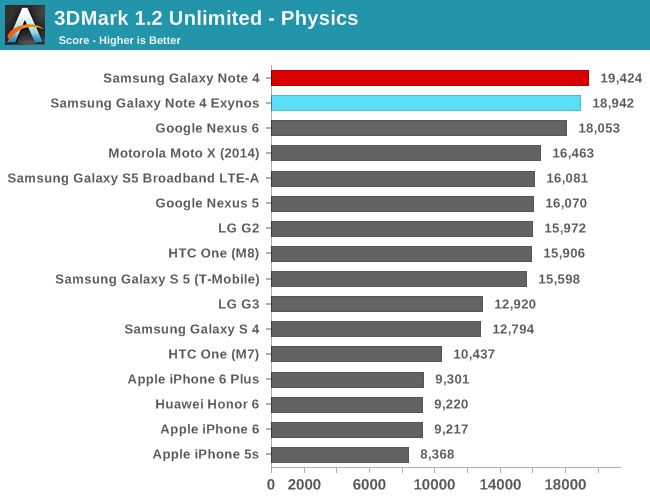
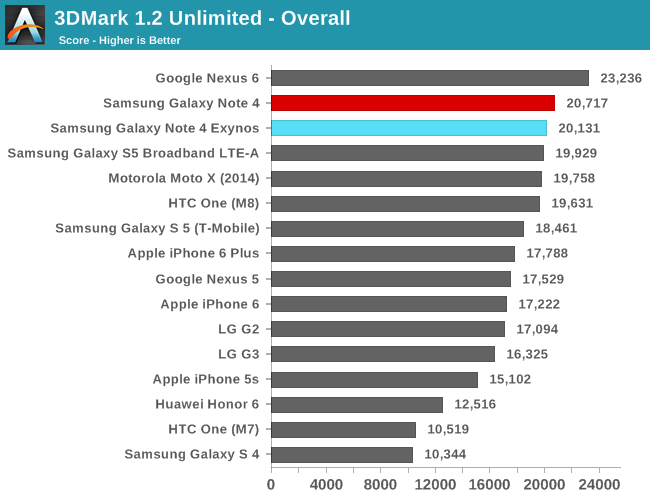
In 3DMark Unlimited the Exynos version comes just short of a few fps behind the Adreno 420. What is also surprising is that the Exynos 5433 performs much better in the physics score than I had anticipated; the same test on Huawei's SoCs limited the thread onto the little cores in the default settings giving mediocre performance results. However, it seems the A53 is performing much better and is able to match Qualcomm's offering now.
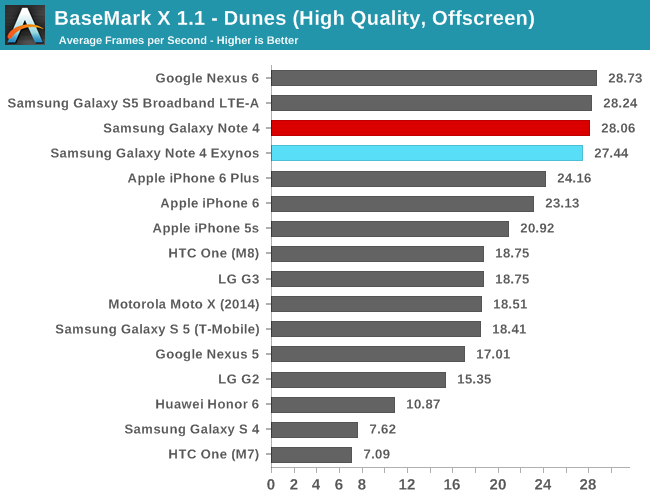
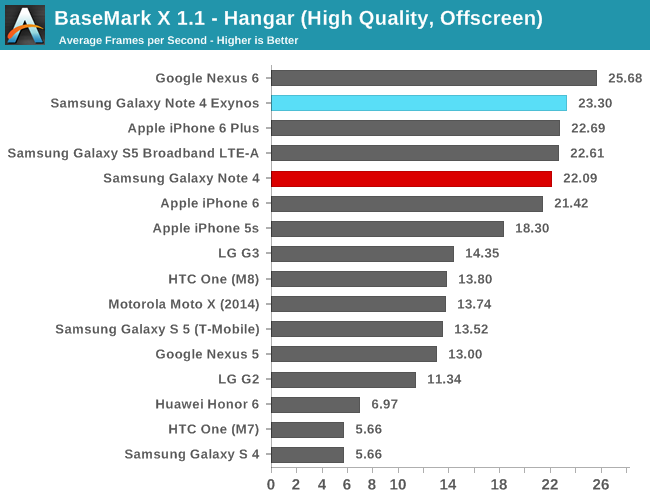
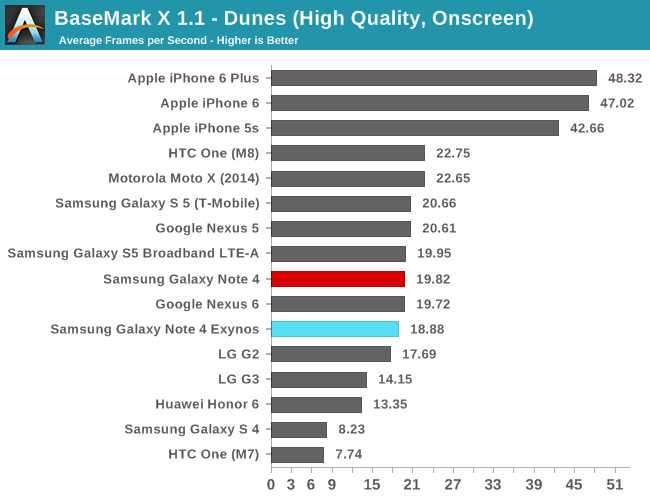

In BaseMark X 1.1, the Exynos is again neck-and-neck with the Snapdragon version. It loses by a slight margin in the Dunes benchmark while winning in the Hangar scenes by a similarly small margin. BaseMark X is again one of the benchmarks that can trigger the 700MHz state of the Mali GPU, offering higher performance at a much higher power draw depending on which scene is currently rendered on both tests.
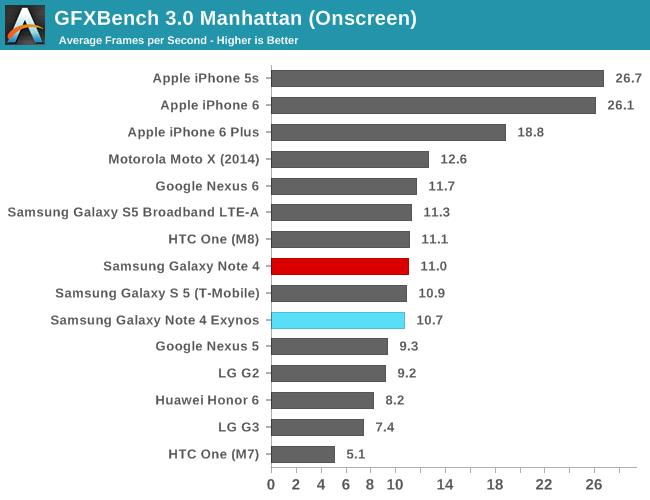
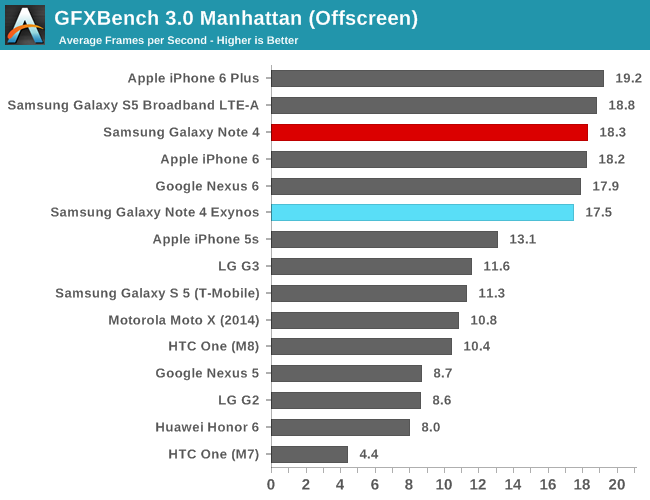
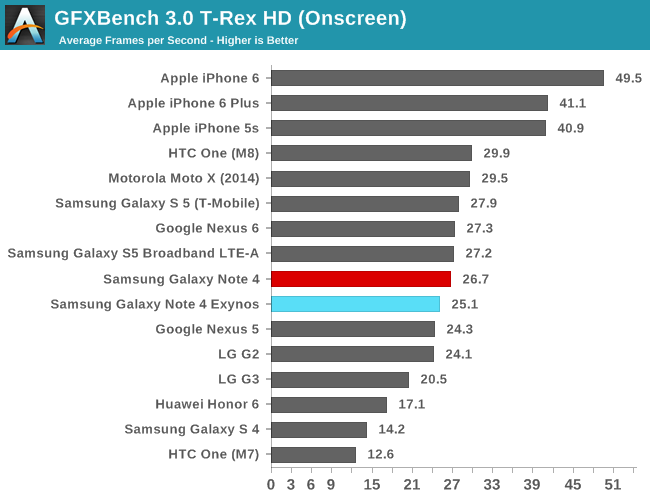
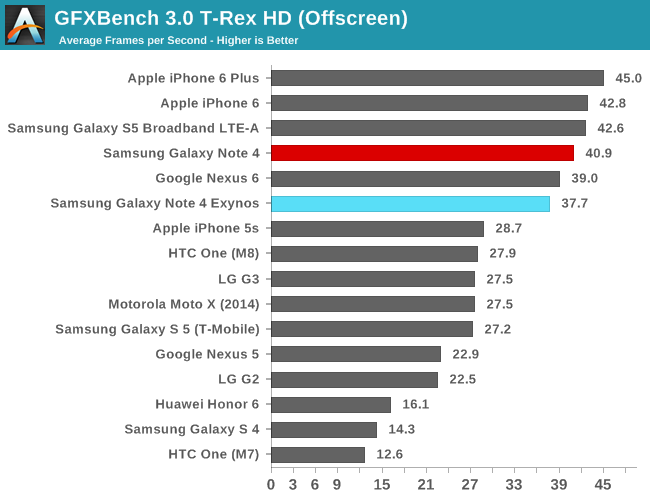
Again we continue to see the same pattern in GFXBench's scenario benchmarks, with the Exynos version lagging a few frames behind the Qualcomm GPU in both Manhattan and T-Rex, in both on-screen and off-screen results.
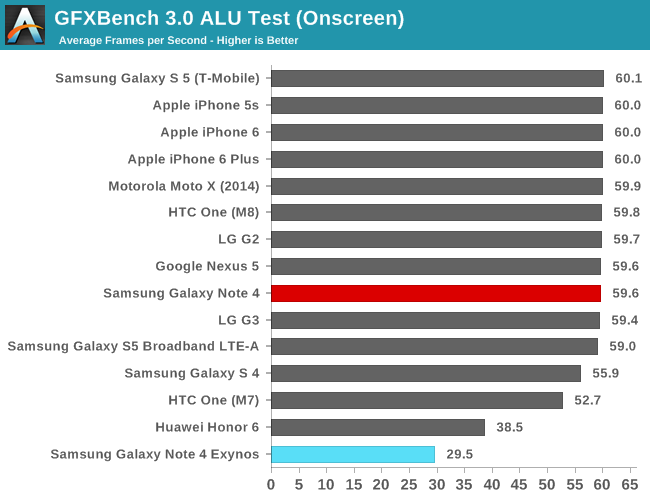

It's on the synthetic tests that we finally see some major deviation between the two architectures. ARM's Mali simply can't seem to keep up with the ALU throughput of Qualcomm's architecture. Both the Adreno 330 and 420 have a clear computational power advantage, exceeding even Imagination's PowerVR GPUs in the iPhones, leaving Mali strictly on the lower end of the performance spectrum.
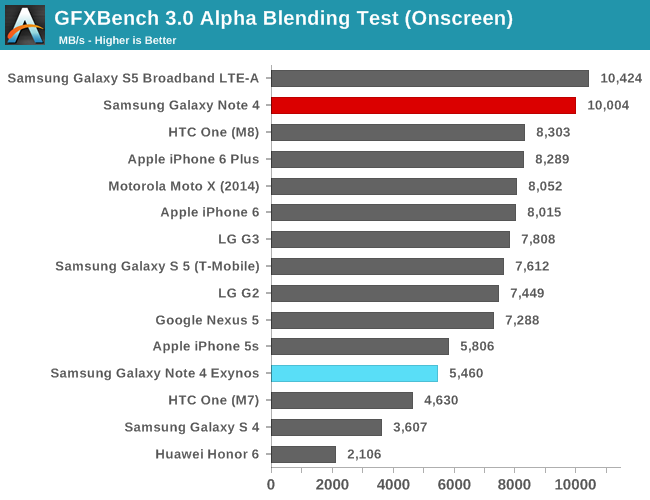
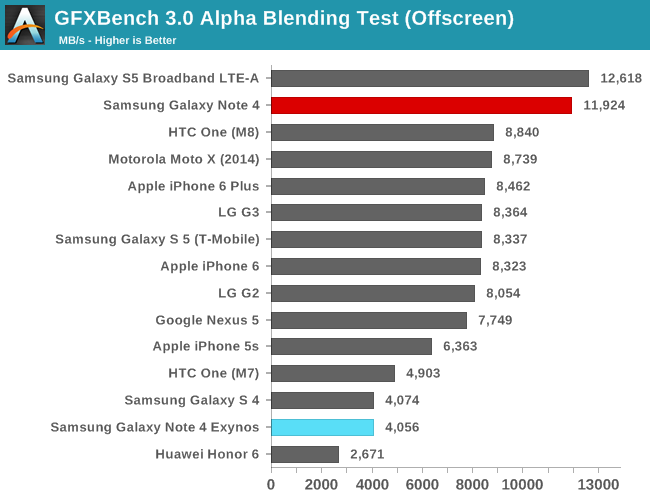
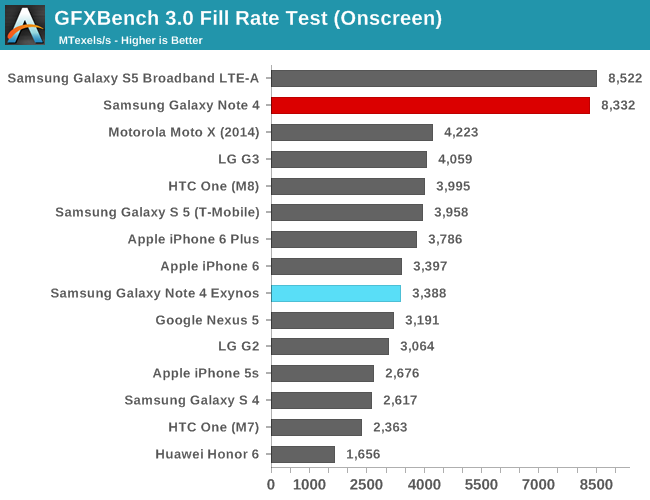
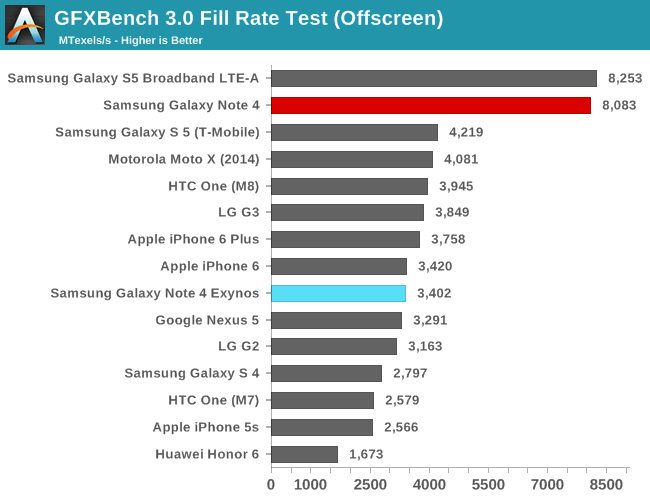
We see a similar situation in the Alpha Blending and Fillrate tests, as the Adreno offers 2-3x the throughput. Utilizing the extra memory bandwidth here seems to be key to the success of the Snapdragon 805's graphics performance.

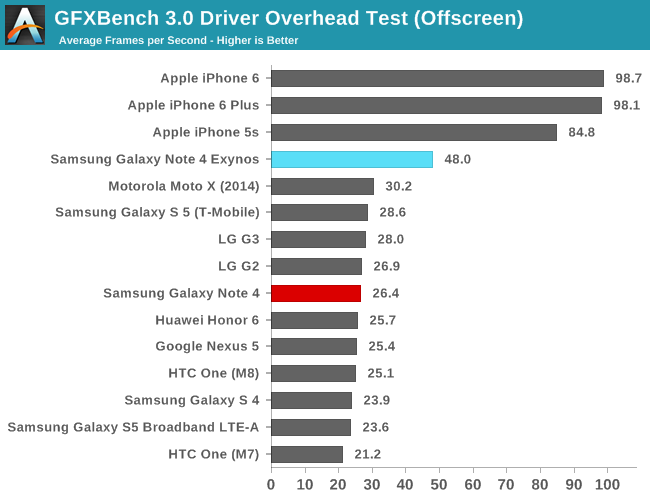
I've already mentioned the Driver Overhead score in the the more in-depth analysis of the T760. It's the first Android device to truly stand out from the rest of the crowd, finally making some progress into trying to catch up with Apple's excellent performance on iOS. Here's hoping more vendors concentrate on improving this metric in future driver updates.
I did some extensive power measurements on the Note 4 Exynos in this review, so naturally we're keen to see how this transforms into our battery benchmarks on the next page.










135 Comments
View All Comments
Andrei Frumusanu - Tuesday, February 10, 2015 - link
The article was never intended to be released this late, so no.Shadowmaster625 - Tuesday, February 10, 2015 - link
I'm just not seeing this huge trouncing of the 805. Where is it? It is ahead slightly, but its battary life suffers by what appears to be a roughly equal amount. So it is basically the same as an overclocked 805. But the 805 is an older more straightforward, proven design and it is probably quite a bit cheaper at this point.extide - Tuesday, February 10, 2015 - link
It's not supposed to trounce it...tipoo - Tuesday, February 10, 2015 - link
Power draw increases *more* than proportionally with clock speed, so an overclocked S805 matched to the performance of these would likely draw more power than them.But yes, I do agree that the tradeoff is less than exciting. Denver also draws too much power, so we really don't have much in the Android SoC space.
lopri - Tuesday, February 10, 2015 - link
Geez. The article is too in-depth! ;) I do not know how long it will take for me to finish reading but I wanted to say thank you ahead.Tikcus9666 - Tuesday, February 10, 2015 - link
All these phone reviews are overkill IMO the first one of any giving technology or OS is relevant the rest not so much, there are only a few things important with a phone(smart or other).This one is slightly more relevant since it looks at 2 phones marketed as the same device (however since both versions are not available in the same region it is a mute point)
Can you make phone calls without it dropping the call
Can you send and receive text messages
Does opening email, or any applications happen in a timely fashion
Does it work without crashing
If 1 phone renders a web page a few MS faster than another, it does not matter
If 1 phone can run a game at a few more FPS it does not matter if the slower phone offers acceptable performance.
If a photo is slightly better on phone a compared to phone B it doesn't matter since it is not good enough to print anyway (unless they start putting proper sensors at least 1/2.3, on phones you will never take acceptable photos). As long as it is good enough to view on the 4/5/6" screen to capture the moment it is good enough.
TomWomack - Tuesday, February 10, 2015 - link
But this isn't a review of a phone. If you want a review of a phone, many specialised phone-reviewing sites which look at stupid details to do with phone calls and text messages are available.This is a review of a processor and a GPU; quite plausibly the people at ODROID will make the processor and GPU available on a convenient mini-ITX-sized board with an HDMI connector before Christmas, at which point knowing the cache configuration of the computer is quite handy.
blzd - Saturday, February 14, 2015 - link
I think you may have made a left when you should've made a right.We don't come to Anandtech to see that "yet another SoC delivers acceptable performance, you can all go home now!" lol.
Cygni - Tuesday, February 10, 2015 - link
I was worried about AnandTech without Anand and Brian's insanely thorough testing and writing style. I'm feeling a lot better after reading this article. Great job Andrei/Ryan, great article.lilo777 - Tuesday, February 10, 2015 - link
in fact the opposite is true. With Anand and Brian, Apple products always were praised beyond the reason. Not the case here (although it's primarily a comparison between non-Apple products). Just pure technical stuff as is.